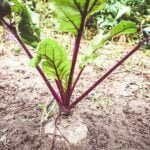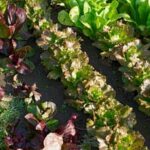Vegetable gardening has become increasingly popular in recent years as people seek to reconnect with nature and enjoy the benefits of growing their own food. The satisfaction of harvesting your own fresh vegetables and knowing exactly where they come from is unmatched. In this blog post, we will delve into the exciting world of gardening vegetables, providing creative and practical ideas to help you cultivate a successful vegetable garden.
Growing your own vegetables offers numerous benefits, both for your health and the environment. Firstly, it allows you to have control over what goes into your food. By avoiding harmful pesticides and choosing organic practices, you can ensure that the vegetables you consume are safe and nutritious. Additionally, cultivating a vegetable garden reduces your carbon footprint by reducing transportation emissions associated with grocery store produce.
The aim of this blog post is to inspire and guide you in creating a thriving vegetable garden. We will explore topics such as selecting the best location for your garden, essential tools and equipment needed for success, soil preparation techniques, choosing suitable vegetable varieties, companion planting strategies for maximizing yields and pest control, seasonal gardening tasks, overcoming common challenges, captivating container gardening ideas for limited spaces, and more.
Get ready to immerse yourself in the beauty of gardening vegetables as we embark on this exciting journey together.
Selecting the Best Location and Layout for Your Vegetable Garden
When it comes to gardening vegetables, one of the most critical factors for success is selecting the right location and layout for your vegetable garden. Choosing an appropriate location can make all the difference in achieving a thriving garden. The first consideration is sunlight exposure – vegetables generally require at least six hours of direct sunlight per day. Therefore, it’s essential to find a spot that receives ample sunlight throughout the day.
In addition to sunlight, factors such as access to water, soil quality, and proximity to other structures or plants should also be taken into account when choosing a location. Avoid areas with poor drainage or where water tends to pool. Furthermore, try to stay away from areas near large trees or shrubs that may compete with your vegetable plants for nutrients.
Once you have identified the right location, it’s time to consider the layout of your vegetable garden. There are various options to choose from, depending on your space constraints and personal preferences. Raised beds not only provide good drainage but also allow you to control the soil quality more effectively.
Container gardening is an excellent option for those with limited outdoor spaces or who prefer the convenience of mobility. Vertical gardening is another innovative approach that maximizes space utilization by growing vegetables upwards on trellises or walls.
Whichever layout you decide on, it’s essential to plan accordingly and manage space efficiently. Consider using techniques such as intercropping or succession planting to maximize yields and optimize space usage in your vegetable garden. By strategically arranging plants based on their growth habits and spacing requirements, you can make the most of your available area while promoting healthy growth and avoiding overcrowding.
Essential Tools and Equipment for Successful Vegetable Gardening
One of the key factors in achieving success in vegetable gardening is having the right tools and equipment. Whether you are a beginner or an experienced gardener, having the essential tools can make your gardening experience more efficient and enjoyable. The following is a list of must-have gardening tools and equipment for successful vegetable gardening:
- Hand Trowel: A hand trowel is a versatile tool that allows you to dig small holes, transplant seedlings, and remove weeds. Look for a trowel with a comfortable handle and a sturdy blade.
- Garden Fork: A garden fork is essential for breaking up compacted soil, mixing in compost or other amendments, and aerating your garden beds. Opt for a garden fork with strong, sharp tines.
- Pruning Shears: Pruning shears are necessary for trimming back overgrown vegetation, harvesting vegetables, and removing dead or diseased plants. Choose pruners with high-quality blades and a comfortable grip.
- Garden Hoe: A garden hoe is ideal for cultivating the soil, removing weeds, and forming furrows for planting seeds. Select a hoe with a durable head that suits your preferred gardening style (e.g., flat or pointed).
- Garden Rake: A garden rake is useful for leveling soil, breaking up clumps, and removing debris from your garden beds. Look for a rake with sturdy tines and an ergonomic handle.
- Watering Can or Hose: Adequate watering is crucial for the health and productivity of your vegetable plants. Invest in a watering can or hose that provides a gentle flow to avoid damaging delicate seedlings.
- Wheelbarrow or Garden Cart: Having a wheelbarrow or garden cart will make it easier to transport heavy soil amendments such as compost or mulch around your garden space.
- Gardening Gloves: Protecting your hands while working in the garden is essential to prevent blisters, cuts, and exposure to harmful substances. Choose gloves that fit well, are breathable, and provide good grip.
- Gardening Hat and Sunscreen: Since vegetable gardening often involves spending long hours outdoors, it’s important to protect yourself from the sun’s harmful rays. Wear a wide-brimmed hat and apply sunscreen regularly.
- Garden Labels: Keeping track of your vegetable varieties is crucial for proper care, identification, and future reference. Use garden labels or markers to label your plants and keep organized records.
Remember that investing in quality tools and equipment will save you time, effort, and money in the long run. Proper maintenance and care of your gardening tools will also ensure their longevity. Clean your tools after each use, sharpen blades when needed, and store them in a dry place to prevent rusting.
By having these essential tools on hand, you’ll be well-equipped to tackle any task that comes your way in your vegetable garden.
Planning and Preparing the Soil for Optimal Vegetable Growth
The Significance of Soil Fertility and Preparation
One of the key factors in ensuring optimal vegetable growth is having fertile soil. Before planting your vegetables, it is crucial to assess the quality of your soil and make any necessary amendments. Fertile soil provides a rich source of nutrients that plants need for healthy development, leading to more robust growth, better yields, and higher-quality produce.
Soil preparation involves several steps to create an environment that supports optimal plant growth. Start by removing any weeds or vegetation from the planting area. Clearing the area ensures that your vegetables won’t have to compete with unwanted plants for water and nutrients. Additionally, removing debris avoids potential hiding places for pests and diseases.
Soil Testing Methods
To determine the suitability of your soil for vegetable gardening, conducting a soil test is essential. Soil testing helps evaluate factors such as pH levels and nutrient deficiencies, allowing you to make informed decisions regarding soil amendment.
A simple method for testing pH levels is using a DIY kit or sending a sample to a laboratory. The ideal pH range varies depending on the vegetables you wish to grow but generally falls between 6.0 and 7.5. Adjustments can be made using lime to raise pH levels or sulfur to lower them.
Another critical aspect of soil testing is checking nutrient content. A complete soil analysis will provide information on essential nutrients like nitrogen, phosphorus, potassium, calcium, and others needed by plants in varying amounts. By understanding your soil’s nutrient deficiencies, you can add organic matter or apply fertilizers specific to those needs.
Guidelines for Soil Amendment and Organic Practices
After obtaining the results from your soil test, it’s time to amend the soil based on its specific needs. Organic practices are highly recommended as they promote long-term fertility while minimizing environmental impact.
Adding organic matter is an effective way to enhance soil fertility and structure. Materials such as compost, well-rotted manure, or leaf mold contribute organic matter to the soil, improving its ability to retain water and nutrients. Organic matter also encourages the growth of beneficial microbes that aid in breaking down organic materials and releasing nutrients.
In addition to organic matter, utilizing cover crops can benefit your soil. Cover crops like legumes (e.g., clover or alfalfa) are known for their nitrogen-fixing abilities and can help replenish this essential nutrient in the soil. Other cover crops may be used to suppress weeds, prevent erosion, and improve overall soil health.
By following these guidelines for soil amendment and implementing organic practices, you can create an optimal growing environment for your vegetables, leading to healthier plants and bountiful harvests.
Choosing the Perfect Vegetable Varieties for Your Garden
When it comes to gardening vegetables, one of the most exciting aspects is choosing which varieties to grow. The wide range of vegetables available can be overwhelming, but with a little research and planning, you can select the perfect varieties for your garden. This section will explore various factors to consider when choosing vegetable varieties and highlight some popular options known for their flavor, color, and versatility.
Considerations for Choosing Vegetable Varieties
When selecting vegetable varieties for your garden, it’s important to consider several factors. Climate and growing conditions play a significant role in determining which vegetables will thrive in your area. Research which vegetables are well-suited for your region’s temperature and weather patterns.
Your level of experience as a gardener is another crucial consideration. Some plants require more attention and care than others, so if you’re new to gardening, start with easy-to-grow varieties that are more forgiving of beginner mistakes.
Another factor to consider is the purpose or use of the vegetables you plan to grow. Do you want them mainly for fresh eating? Or are you looking to preserve them through canning or freezing? Some varieties may excel in certain applications, so identify your goals before making your selection.
Heirloom vs. Hybrid Varieties
One decision you’ll encounter when choosing vegetable varieties is whether to go with heirlooms or hybrids. Heirloom varieties are older plant types that have been preserved through generations because of their desirable traits such as unique flavors or historical significance. They often come in a wide array of colors and shapes but may have lower disease resistance compared to hybrids.
On the other hand, hybrid varieties are created by crossing two different parent plants with specific characteristics resulting in offspring that exhibit desired traits such as disease resistance or uniformity. Hybrids tend to have higher yields and improved pest resistance compared to heirlooms but may lack the diversity of flavors found in heirloom varieties.
Popular Vegetable Varieties
Now that we’ve discussed some considerations let’s explore a few popular vegetable varieties that are well-regarded for their taste, versatility, and adaptability:
– Tomatoes: Varieties like ‘Brandywine’, ‘Cherokee Purple’, and ‘Sun Gold’ are beloved for their exceptional flavors, while determinate varieties like ‘Celebrity’ and ‘Roma’ are favored for canning.
– Lettuce: From the loose-leaf variety ‘Red Sails’ to the crisphead variety ‘Iceberg’, there are countless lettuce options to choose from. Consider mixing different types to create a diverse salad blend.
– Bell Peppers: Whether you prefer green, red, yellow, or orange peppers, there is a variety suitable for every taste preference. Classic choices include ‘California Wonder’, ‘Red Beauty’, and ‘Golden California Wonder’.
– Zucchini: This prolific summer squash comes in various shapes and colors. Popular varieties include the traditional green zucchini as well as yellow varieties such as ‘Golden Glory’ and striped ones like the Italian heirloom ‘Costata Romanesco’.
Remember to select vegetable varieties that align with your growing conditions, gardening experience, and culinary preferences. Experimenting with different varieties each year can add excitement to your garden while expanding your knowledge of different flavors and cultivars.
Creative Companion Planting Ideas for Maximizing Yields and Pest Control
Companion planting is a gardening technique where different plants are grown together to benefit each other. It can help maximize yields by increasing pollination and enhancing nutrient uptake. Additionally, companion planting can aid in pest control by confusing or repelling pests that are harmful to certain plants. In this section, we will explore some creative companion planting ideas that you can implement in your vegetable garden.
One popular combination is growing tomatoes alongside basil. Basil helps repel pests like tomato hornworms and aphids, while also enhancing the flavor of tomatoes. Another beneficial pairing is cabbage and dill. Dill attracts predatory insects that feed on cabbage pests such as cabbage worms and aphids.
To create a diverse garden ecosystem, consider planting flowers among your vegetables. Marigolds are known to deter nematodes, which can damage the roots of many vegetable crops. Nasturtiums not only add a pop of color but also attract aphids away from vegetables like lettuce and cucumbers.
In addition to traditional companion planting, you can also incorporate intercropping techniques for even greater benefits. Intercropping involves growing different types of plants closely together so that they complement each other’s growth patterns and resource needs. For example, interplanting corn with beans has been practiced for centuries by Native American farmers. The cornstalks provide support for the climbing beans, while the beans fix nitrogen in the soil, benefiting both crops.
| Companion Plant | Main Benefits |
|---|---|
| Basil | Repels pests like tomato hornworms and enhances tomato flavor |
| Dill | Attracts predatory insects that feed on cabbage pests |
| Marigolds | Deters nematodes that can damage vegetable roots |
| Nasturtiums | Attracts aphids away from lettuce and cucumbers |
Remember to consider the specific needs and compatibility of plants when planning your companion planting combinations. Observing plant interactions in your garden and experimenting with different pairings can lead to successful outcomes and a thriving vegetable garden.
Seasonal Gardening
When it comes to vegetable gardening, understanding the seasonal tasks is crucial for successful outcomes. Each season brings specific requirements and opportunities for sowing, growing, and harvesting your vegetables. By following a well-designed gardening calendar and implementing timely techniques, you can optimize your garden’s productivity and enjoy a bountiful harvest year-round.
Spring
During spring, the temperature starts to rise, signaling the perfect time for sowing cool-season crops. Begin by preparing the soil through tilling or loosening it with a garden fork. Remove any weeds or rocks that may hinder plant growth. You can also consider adding compost or organic matter to enhance soil fertility.
Some popular vegetables to sow in spring include lettuce varieties, spinach, radishes, peas, and carrots. These crops thrive in cooler temperatures while benefiting from ample sunlight exposure. Plant them directly into the ground or start seeds indoors before transplanting them outdoors once they have developed strong seedlings.
Summer
Summer is a busy season for vegetable gardeners as warm-season crops take center stage. Make sure your garden receives at least six hours of direct sunlight daily for optimal growth. Remember to water deeply but infrequently to encourage deep root development.
Tomatoes, peppers, cucumbers, zucchini, beans, and corn are popular choices for summer gardens. It’s best to start these plants from transplants rather than seeds as they require a longer growing season. Monitor the moisture levels regularly and provide mulch around plants to retain soil moisture during hot summer days.
Fall
As temperatures begin to drop in fall, it’s time to transition back to cool-season crops that thrive in cooler weather conditions. Start by removing any spent summer plants and weeds from your garden beds. Clearing out debris helps prevent potential disease or pest problems during the colder months.
Fall is the ideal time to sow crops such as kale, broccoli, cauliflower, Brussels sprouts, and carrots. These vegetables benefit from the cooler temperatures and have a sweeter flavor when harvested after experiencing light frost. Extend your growing season by using row covers or cold frames to protect your plants from early frosts.
Winter
Winter gardening might seem challenging, but with proper planning, it’s possible to enjoy fresh vegetables even in colder climates. Consider utilizing a greenhouse or constructing a low tunnel to create a protected environment for cold-tolerant crops.
Leafy greens like lettuce, spinach, and arugula are excellent choices for winter gardening. They can withstand lower temperatures and provide a fresh harvest during the dormant months. Additionally, you can also cultivate root crops such as beets and turnips which tend to store well in the ground or root cellar.
Remember, the seasonal tasks mentioned here are general guidelines and may vary depending on your specific climate zone. It’s essential to research and adapt your gardening techniques accordingly to ensure optimal results.
By following this seasonal approach to vegetable gardening, you can make the most of each growing period while ensuring a diverse selection of fresh produce throughout the year. So grab your gardening gloves and seeds – it’s time to start sowing, growing, and harvesting your own vegetables.
Expert Tips for Overcoming Common Vegetable Gardening Challenges
Growing a successful vegetable garden can sometimes be challenging, especially for those new to gardening. However, with the right knowledge and strategies, common challenges can be easily overcome. In this section, we will discuss some expert tips to help you tackle frequently encountered issues in vegetable gardening.
One of the most common challenges in vegetable gardening is dealing with pests and diseases. To prevent these problems, it is important to practice good garden hygiene and implement preventive measures such as crop rotation and proper spacing between plants. Additionally, companion planting can play a significant role in controlling pests naturally. For example, planting marigolds alongside your vegetables can deter pests like aphids and nematodes.
Watering is another challenge that many gardeners face. It is crucial to maintain proper hydration for your vegetables without overwatering them. One useful tip is to water your plants deeply and less frequently rather than shallow watering more often. This encourages deep root growth and makes the plants more drought-tolerant. Mulching around your plants helps retain moisture in the soil, reducing water evaporation.
Nutrient deficiencies can also occur in vegetable gardens if the soil lacks essential elements. Regularly testing the soil’s pH levels and nutrient content is important to ensure optimal plant health and productivity. If deficiencies are detected, organic fertilizers or compost can be added to enrich the soil. Another important aspect of nutrient management is proper timing of fertilization throughout the growing season.
By implementing these expert tips, you will be better equipped to overcome common challenges that arise while tending your vegetable garden. Remember that gardening is a continuous learning process, so don’t hesitate to seek advice from experienced gardeners or consult reliable resources for further information on specific issues you may encounter.
Captivating Container Gardening Ideas for Limited Spaces
Container gardening is an excellent option for those with limited outdoor spaces or urban dwellers who don’t have access to a traditional garden. With some creativity and planning, you can transform even the smallest balcony or windowsill into a thriving vegetable garden. In this section, we will explore some captivating container gardening ideas that will inspire you to make the most of your limited space.
One idea for container gardening in limited spaces is vertical gardens. Vertical gardens utilize wall space by growing plants vertically instead of horizontally. You can create a stunning display by using hanging pockets, trellises, or stacking boxes to maximize your growing area. Vegetables like tomatoes, cucumbers, and beans are well-suited for vertical gardening and can be trained to grow upwards. Not only does this method save space, but it also adds an aesthetic appeal to your outdoor area.
Hanging baskets are another great option for container gardening in limited spaces. Hang them from hooks on a balcony railing or attach them to sturdy brackets on walls or fences. This allows you to make the most of your vertical space while adding beauty and greenery to your environment.
Leafy greens like lettuce, spinach, and kale thrive in hanging baskets and are easy to care for. Additionally, herbs such as basil, parsley, and mint can be grown in hanging baskets for a convenient and flavorful addition to your meals.
Window boxes are perfect for those with limited outdoor space but still want to enjoy the benefits of gardening vegetables. These long containers sit on window sills or hang beneath windows and can hold various vegetables depending on their depth.
Window boxes not only provide beauty but also allow you to grow edible plants right outside your kitchen window, making it easy to harvest fresh ingredients whenever you need them. Consider planting compact vegetables like radishes, carrots, or cherry tomatoes in window boxes as they don’t require much depth and can thrive in smaller containers.
Container gardening opens up possibilities for anyone who wants to grow vegetables despite limited space. Whether it’s through vertical gardens, hanging baskets, or window boxes, there are numerous creative approaches that can turn your small living area into a green oasis. Experiment with different container sizes and varieties of vegetables to find what works best for you. With a little innovation and care, you can enjoy the beauty and bounty of gardening vegetables in even the tiniest spaces.
Conclusion
In conclusion, gardening vegetables not only provides a fulfilling and rewarding experience but also offers numerous benefits. Throughout this blog post, we have explored various aspects of gardening vegetables, from selecting the best location and layout to choosing the perfect vegetable varieties. We have discussed essential tools and equipment, soil preparation techniques, and even creative companion planting ideas for maximizing yields and pest control.
One key takeaway from this article is the importance of embracing the beauty of gardening vegetables. By growing our own vegetables, we have the opportunity to reconnect with nature, gain a sense of self-sufficiency, and promote sustainable living. The joy of witnessing seeds transform into thriving plants and reaping the harvest cannot be underestimated. Additionally, gardening vegetables allows us to control what goes into our food and ensures access to fresh, nutritious produce.
We encourage readers to take these gardening ideas as inspiration and embark on their own vegetable gardening journey. Whether you have limited space or ample land, there are options available for everyone to cultivate their own patch of greenery. Embrace experimentation, learn from experienced gardeners’ tips shared in this post, and don’t be afraid to try new techniques.
We invite readers to share their experiences, tips, success stories, or any challenges they encountered in the comments section below. Let’s create a community where we can learn from one another’s triumphs and help each other overcome obstacles along the way. Remember, no matter how small your garden may be, it has the potential for beauty both aesthetically and nutritionally.
So let’s sow some seeds, tend to them with care, and reap the many rewards that come with gardening vegetables. Happy gardening.

If you’re looking to get into vegetable gardening, or are just looking for some tips on how to make your current garden better, then you’ve come to the right place! My name is Ethel and I have been gardening for years. In this blog, I’m going to share with you some of my best tips on how to create a successful vegetable garden.





